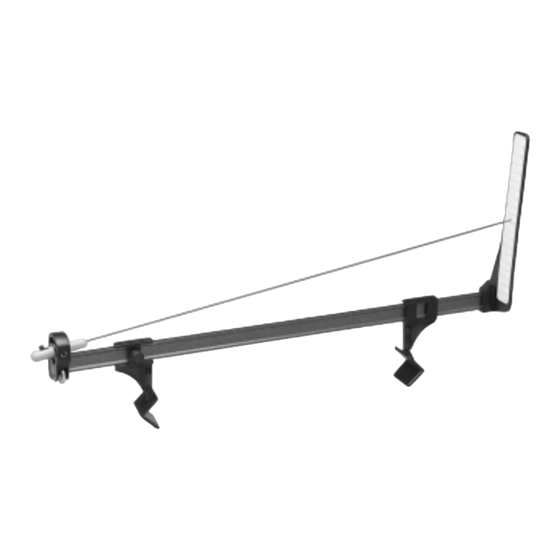
Advertisement
Quick Links
Congratulations! You are now the proud owner of a precision incidence measuring tool. The Great
Planes Accu-Point
™
check your airplane with a degree of precision that was never before possible.
Why use an incidence meter?
Model airplane designers create aircraft with specific performance goals in mind. The airplane's spec-
ifications and angles are set and verified thorough extensive testing and measuring to achieve their
design goals. When building a model airplane from a kit, you are, in effect, making a duplicate of a
model that was built and tested by an experienced design team. It is up to you, the modeler, to make
sure that the airplane is straight and true during assembly. If the wing incidence or engine thrust does
not match the design specifications, the airplane will not fly as intended by the designer. Many flight prob-
lems can be traced down to some kind of misalignment or twist between flight surfaces. Using the
Great Planes Laser Incidence Meter, you can easily pinpoint inaccuracies in your model and correct
them.
For the helicopter pilot, the Great Planes Laser Incidence Meter can be used to accurately measure
the pitch of the main rotor blades and to fine tune pitch curves.
Please read through the instructions and safety precautions to familiar-
ize yourself with the proper operation of this tool.
P.O. Box 788
© Copyright 1999
Laser Incidence Meter is accurate to within 1/4º. This allows you to set-up and
Urbana, IL 61803 (217) 398-8970
INSTRUCTION MANUAL
www.greatplanes.com
GPMZ0254 for GPMR4020 V1.0
Advertisement

Summary of Contents for GREAT PLANES AccuPoint
- Page 1 Great Planes Laser Incidence Meter, you can easily pinpoint inaccuracies in your model and correct them. For the helicopter pilot, the Great Planes Laser Incidence Meter can be used to accurately measure the pitch of the main rotor blades and to fine tune pitch curves.
-
Page 2: Safety Precautions
SAFETY PRECAUTIONS 1. DANGER: This tool uses a laser diode. A laser beam can be harmful to the eyes. Do not look directly into the laser beam while the unit is turned on. Also, laser light, when reflected off a mirror or similar reflective surface, can be dangerous. 2. - Page 3 2. Install the batteries: The back of the laser unlocks for easy installation of the bat- teries. Install the batteries noting the polarity. 3. Check the operation of the laser assembly. The weight and laser should rock freely in the bearings. Adjust the left/right position of the weight block as needed for friction- free movement.
-
Page 4: Operation
OPERATION The Great Planes Laser Incidence Meter can be used to measure the angular align- ment of various components of your airplane. 1. Stabilizer incidence relative to a reference point. 2. Wing incidence relative to a reference point (typically the stabilizer) 3. - Page 5 3. Turn on the laser. Hold the laser and rotate the weight block until the laser balances and points at 0°(or to the manufacturer’s specification for your chosen reference line). To fine tune the reading to 0°, turn the brass wheel until the reading is exact. 4.
- Page 6 In practice most modelers do not check the stab incidence relative to the datum line. Instead they use the stab as the reference point for checking the other angles. Checking Wing Incidence Most aircraft manufacturers note the incidence angles on their plan sheet, making it easy to find the correct incidence angle specifications for your airplane.
- Page 7 3. Without bumping the laser assembly, attach the meter to the wing close to the fuse- lage. If the meter is attached to an aileron, make sure the aileron stays at neutral. 4. Let the laser come to rest and note the reading. 5.
- Page 8 In some cases, however, a wing twist is desirable to add stability (washout: where the wing tip flies at a lower angle of attack than the wing root). Typically, airplane manu- facturers give specifications on how much washout should be in a wing. Try to get as close as you can, but remember, it is more important that both tips have the same amount of washout to avoid trim problems.
- Page 9 Checking Engine Thrust The engine thrust line is critical. If the angle is too high, the nose of the plane will drop when reducing the power for landing. If it is too low, the plane will balloon up when the power is reduced.
- Page 10 HELICOPTER COLLECTIVE PITCH The Great Planes Laser Incidence Meter works great for accurately measuring the pitch of the rotor blades. 1. Attach the meter to one of the main blades close to the rotor head. Position the grips so they are centered on the bar. This way the weight of the meter won’t try to twist the blade resulting in inaccurate readings.
- Page 11 Great Planes warrants this product to be free from defects in materials and workmanship for a peri- od of one (1) year from the date of purchase. During that period, Great Planes will, at its option, repair or replace without service charge any product deemed defective due to those causes. You will be required to provide proof of purchase (receipt or invoice).
-
Page 12: Data Sheet
DATA SHEET Copy This Form To Record Your Data Right Tip Right Tip Right Root Right Root Left Root Left Root Left Tip Left Tip Engine Thrust Aircraft Name: Date: Reference Line: Stab Left Root: Right Root: Left Tip: Right Tip: Wing Left Root: Right Root:...

Need help?
Do you have a question about the AccuPoint and is the answer not in the manual?
Questions and answers